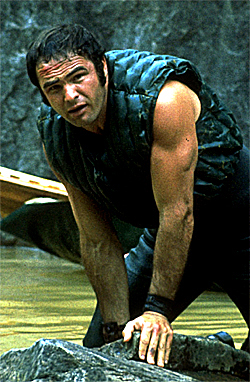Entries Tagged 'trends' ↓
October 26th, 2009 — business, design, economics, philosophy, software, trends
“Disneyland will never be completed. It will continue to grow as long as there is imagination left in the world.” – Walt Disney

Thinking about Eric Ries‘ lean startup methodologies, it occurred to me that Walt Disney pioneered the form in 1955 with the creation of Disneyland. Let’s take a look.
Private Beta: July 17, 1955
Disneyland was officially launched in a private beta in July 1955 to 6,000 guests by invitation only. Unfortunately, those folks shared their invitation links and 22,000 extra guests showed up with forged tickets! Special guests Ronald Reagan and Art Linkletter helped Walt Disney put on a good show that was live-streamed on television.
But the park was anything but a success that first day. Ladies’ heels sunk into the asphalt slurry sidewalks in the hot July sun. A plumbers’ strike meant that only a few water fountains were operational. A gas leak closed several sections of the park.
These setbacks led Disney’s team to refer to this fateful day as Black Sunday. The opening day generated such negative publicity that Disney and his team took special care to invite the press back the next day and in the coming days to see “the real Disneyland” and see things as they had been intended.
But even if things had gone as planned, only 18 attractions were operational those first few days. Tomorrowland had just four attractions and was admittedly incomplete. Several other attractions would open later in 1955 and 1956.
When Disneyland opened in July 1955, it was literally the minimum viable product. With just $5 Million in financing, there was a lot that Walt wanted to put into the park, but there was only so much money and time.
They launched with what they had ready and took the hit for the stuff that was broken. Why? So they could learn from their customers.
Customer Development

Disney listened to his customers. This change log on the site Yesterland.com shows how much stuff opened in 1955 was eliminated or modified over the years.
New rides were added, old ones modified; others became simply obsolete or required updates. The awkward and failure-prone Flying Saucers ride was replaced in 1967 with the Tomorrowland Stage, which was in turn replaced in 1986 with the Magic Eye Theater. The “Rocket to the Moon” became the “Rocket to Mars.” The iconic Matterhorn Bobsleds ride didn’t open until June 1959, nearly four years after the park’s debut!
Disney’s guest relations department has had the benefit of hearing a huge volume of customer feedback – about which attractions people enjoy, which ones they hate, and which ones literally make them sick. With such a powerful mechanism for continually collecting feedback from millions of customers (who take pride in interacting with one of the world’s most prestigious brands), the Disney organization has benefited from a feedback cycle of continuous improvement.
If Disney and his team had gone into “stealth mode” for 55 years, could they ever have produced the park that we see today?
Build On One Success
After Disneyland was successful, and could benefit from a methodology of continuous improvement, they were able to obtain the financing necessary to build Disney World, Epcot, Euro Disneyland, Animal Kingdom, Disney’s California Adventure, and several other projects. You might think of each of these as several products in a portfolio, but they all flowed from the fundamental success of the original and the conviction that it was okay to launch with a halfway-there product in July 1955. They knew that customers would help them find the way forward.
Disneyland has always been the result of the interaction of management and customers to produce an experience that is valuable for its customers and profitable to operate.
Your software business should take the same approach. You don’t know what your customers are going to want. Launch with something workable, even if flawed. Then iterate with continuous improvements after that. Then, you and your customers will be building something valuable together.
Your product should never be completed, as long as there is imagination left in the world!
October 24th, 2009 — art, business, design, economics, philosophy, software, trends
One of the disturbing things we notice as children is that paper money has no inherent value. Why is it that green pieces of paper are accepted in exchange for all manner of goods and services? Because we have all agreed that it should be so.
Mostly, it is because the various sovereign governments whose soil we inhabit have stated that they will accept payment of tax only in these currencies. So we had best have some of it. This demand creates motivation for all of us to work to get at least a minimum amount of it, and many of us would like to have more than a little.
So, we accept this “green lie” as a fact of life. Money makes the world go around, and we’re all playing this game under penalty of deprivation, or incarceration at the worst case.
Waking Up

Just like Neo, we are called to “wake up” and recognize the nature of this system. Socialist-capitalist world governments are a reality that we impose on ourselves; if we can look up and see beyond it, a whole new world opens up.
Currency Is Different from “Money”
Currency, the worthless bits of paper and metal we trade for handy things like food, beer, and fuel works pretty well and we can rest reasonably sure in our ability to use it to survive.
But what about your 401(k)? It’s an illusion. The financial system is engineered to compel you to shuffle the majority of your wealth into ledger accounts that exist only in your mind. And these “account balances” cause you to make all kinds of decisions — whether to eat out tonight, whether to buy a car or a house, whether to overthrow the government — in particular ways. Your behavior is, in a very real way, controlled by how much “money wealth” you perceive you have.
Glitches In The Matrix
When global financial bubbles jitter as they have done in the last 18 months, home values and 401(k) balances can be badly hurt. These downturns in perceived fortune, in a very real way, cause people to modify their behavior. Maybe you won’t eat out, maybe you won’t take that trip, maybe you won’t start a business. Why do you change your behavior when none of this is real?
Political Implications
Historically, governments are overthrown when unemployment reaches a sustained 15-20%. Current Keynesian fiscal policy adopted by the Fed is aimed at having a variety of control mechanisms to stimulate the economy (lower interest rates; bank lending; TARP mechanisms) when unemployment gets out of control.
But, as we have seen, these market interventions usually lead to unintended consequences. It’s been widely stated that the bank and insurance bailouts were “gifts” to firms like Goldman Sachs who disproportionately benefited from “loopholes” in the regulatory climate. You and your children will certainly pay for these mistakes in the form of devalued currency and sustained taxation.
My point here is to emphasize that monetary policy is an instrument of the state which is used to keep the populace in-line. The debates between the left and right over tax policy are pointless when fiat money allows the Federal Reserve to tweak the knobs of reality at will. And as long as you are motivated by money, you are under the control of this system — and the debates of left and right are just distractions to keep the masses busy. Bush? Obama? Who cares. It probably doesn’t matter to your bottom line. If it doesn’t matter to your personal security, why worry about it?
Finding Inherent Value
Do you ever wish you had a real skill? I don’t mean manipulating ideas or paper, but something tangible? Doctors can trade their services for food. Builders could trade their services for future return of garden produce.
What if your 401(k) was simply gone tomorrow? I don’t mean badly eroded, but gone. What would your future look like? What would be left for you if the monetary system — and all of our current economic system — went bust? What would you have left?
I’d argue you have more than you might imagine. You have family, friends, some basic skills, and an ability to trade effort for necessities. Because everyone would be in the same boat, this would be easier than you might imagine (though it would certainly be chaos).
Current social network tools allow you to start building an economy in the form of interpersonal relationships; by sorting people by shared interests and shared inherent motivations, these tools allow people who find meaning in the same things to find each other. And meaning is at the heart of interpersonal exchange.
Do Important Things
If you endeavor to do things that matter — things that help others, things that change the world, things that have meaning — you will accrue amazing awards in interpersonal relationships. People respect leaders. People respect those who make sacrifices for others. If you’re only in it for yourself and your ability to extract imaginary cash from the system, where will you be when the system fails?
“The System’s Gonna Fail”

In the 1972 film Deliverance, Lewis Medlock (Burt Reynolds) makes a case that “the system’s gonna fail.”
Burt Reynolds: “Machines are gonna fail, and the system’s gonna fail… then…”
Jon Voight: “And then what.”
Reynolds: “Then, survival — who has the ability to survive. That’s the game… survival.”
Voight: “And you can’t wait for it to happen, can ya? You can’t wait for it… Well, the system’s done all right by me.”
Reynolds: “Oh, yeah… You got a nice job, got a nice house, a nice wife, a nice kid.”
Voight: “You make that sound rather shitty, Lewis.”
He may be slightly exaggerating the situation, but when you read books like Extraordinary Popular Delusions and the Madness of Crowds (Charles Mackay, 1842 – yes, 1842!) you start to realize that the financial system we have now is only different from those in the past in that we don’t yet know how this one will fail.
That’s right: we just don’t know how this ends, but it will most assuredly end.
Cash as a Symptom of Good Work
If you spend your days creating real change, the distribution platform for your ideas and your work is larger and less expensive than ever before. Do something original and the entire world is your audience. Do something great and the world will want to reward you.
You can accrue massive “whuffie” in interpersonal relationships, but you’ll also very likely accrue a lot of cash if you do work that is both original and inherently valuable.
And since there’s no way of knowing when the system’s gonna fail, it’s best to simply do good work and build strong relationships. Then you’re covered no matter what happens.
You can only master the matrix when you stop playing by its rules. Wake up, Neo.
October 24th, 2009 — business, design, economics, social media, software, trends
Technology investment bubbles have given many entrepreneurs the impression that success in tech is all about coming up with a “cool idea,” pitching it to a VC, getting funding, building up the business, and then exiting in high style.
First, this is a fairy tale, second, this will not happen to you, and third, what you’re observing is the product of a highly evolved network of peers, of which you are likely not a part.
What Happens in Palo Alto Stays in Palo Alto
What you see taking place in Silicon Valley is the result not of people betting on “cool ideas,” but of people betting on teams and connections. Before every VC deal, there is an exit strategy in mind. Every VC-backed valley startup is an outsourced R&D play.
Ever notice that many large tech firms grow primarily by acquisition? Most have comparatively lean R&D operations; this keeps experimenting off of their balance sheet, thus improving profits and lifting stock prices. Those stock prices are what give them the fuel to make good sized acquisitions, which in turn is the incentive for startups to grow and for VC’s to fund them.
This is the capitalist cycle in its most fully evolved form. Sometimes those acquisitions work out, sometimes they don’t, but the process feeds the machine and it becomes self-perpetuating. This process is literally the grist for the innovation mill that is Silicon Valley.
Why You Should Forget About VC’s — For Now
If you’re not already plugged into this world (meaning you have a lot of contacts there and have a specific idea of a strategy to get funding and an exit before you start), you probably have no place talking about VC’s at all. So ban it from your vocabulary. They’re not interested in you and won’t be. Yet.
Instead, think about how you’re going to build value outside of that network. It is totally possible, but don’t get distracted thinking about VC’s when you should be thinking about bootstrapping and investment from friends, family, and angels.
The good news? Most software startups can be launched for $50K or less these days. Build the minimum viable product, ship it, and then follow lean startup methodologies to iterate towards something that is valuable to the market. Once you have done that, established a revenue stream and can demonstrate some reason why venture capital investment will help you grow fast and capture a market position that you couldn’t capture otherwise, you may be ready to talk to a venture capitalist.
But more likely, investors will come to talk to you! If your startup shows real promise, VC’s will likely seek you out. If you work with some angel investors, they will likely have networks that can help you secure a next round of investment. It will happen naturally. Stop thinking about VC’s. They will find you. Worry instead about building value.
Think Investors, Not VC’s
Yesterday I wrote a post that suggested that entrepreneurs should always think like investors, and always consider what an investor would think of the company. I stand by this, but I am absolutely not talking about VC’s in the early stage. You are not ready for VC’s in the early stage, especially if you are not “plugged in” to the valley culture.
So, think like an investor. Your investors are: you, your family, angels, and possibly local government business development funds. Forget about VC’s for now. If you build value for your yourself, your customers, and your first round of investors, VC’s will come knocking if they think they can help.
October 23rd, 2009 — business, design, economics, software, trends
Entrepreneurs sometimes think that they are the ones “doing the work,” and that investors are but a necessary evil: parasites looking for a free ride on the back of the hardworking startup.
This false dichotomy blinds entrepreneurs to the reality that they, too, are investors and must always think like one. It deeply affects your decision-making process.
The Business Case
Why is your entrepreneurial endeavor a good idea? In a capitalist system, all entrepreneurial activity has just one purpose: to make money. Presumably, your business idea will require the investment of some of both your time and your money. Your time has opportunity cost associated with it (what you could be earning doing something else); and your money could be in the markets earning 5-7%. Over time, your business idea should return a value greater than 7-10% compounded in order to make it worth doing at all. Many businesses can yield several hundred percent returns, either in the form of free cash flow or an exit (selling that cash flow) later on.
You might argue 1) there are other reasons besides making money to start a business, 2) capitalism has flaws, 3) we don’t actually live in a capitalist system. These are fascinating, valid arguments, but let’s put them aside for now.
If you accept the idea that making money is the only reason to start a business, then why would you spend your time and invest your money in a business concept that you would not ask someone else to invest in as well?
Bad answer: Because you don’t think an investor will “get it” and you don’t want to waste your time figuring out how to convince people you don’t know that your idea and team are worthy of their cash.
Good answer: Because you don’t need additional cash and don’t want to give up equity right now. You might consider taking investment after your prototype is complete to make a couple of key hires.
This “bad answer” is a kind of exceptionalism: you think that you are special, that you have all the answers you need, that this time it will be different, and that you won’t ever need investors. But like most exceptionalist attitudes, this mindset is a self-deception.
Always Be Transactable
In economics, transactability is the degree to which something can be traded, usually for money. If you don’t think like an investor yourself, you are adopting a mindset of non-transactability early on. You’re essentially saying, “I don’t even want to think about trading equity for money because I am exceptional and I don’t care about what anyone else thinks of my business.”
The problem with adopting a non-transactable mindset is that it tends to persist and self perpetuate. When do you go from being non-transactable to transactable? When do you decide it’s okay to give up equity to key hires or partners? When do you decide it’s okay to accept a small amount of investment? What will I do when it’s time to sell the business?
Many early-stage entrepreneurs dismiss these questions, assuming that they will “figure them out when they get to them,” or they say that they’ll “never sell their business.” These are both flawed arguments: if you don’t think about how you would trade equity for cash (and vice-versa) from the start, you are likely to handle any situation that requires it poorly.
Your Business Has a Valuation From Day One
This morning, Apple has a market cap valuation of $184.64 Billion (more than Google, less than Walmart). Your business is probably worth less, but it still has a value!
The “valuation” of your business is, quite simply, what someone else would be willing to pay to own it. That is usually a combination of the depreciated value of your assets, less your liabilities, plus a multiple of whatever free cash the business might be available after operating expenses. Some businesses get really high exit multiples (product companies, 8-10X net) and others get lower exit multiples (service companies, 3-4X net). There are no “rules” for business valuation; it’s a lot like home prices. You can look at comparables and take some guesses, but it boils down to what a buyer is willing to pay. It’s nice to have a lot of buyers, too.
You should always be thinking about maximizing the value of your business. What would somebody else pay to be in your shoes? In the early stages, the answer is almost “not much” or even negative. That’s to be expected, but over time, if you succeed the answer will start to be $100K, or $1M, or $10M. You need to be thinking about that trade all the time, and at least have some sense of what your business valuation is and how you might maximize it.
Everybody Is an Investor
You may not think so at first, but you are always asking for investment. If you are hiring someone, they are evaluating your business plan, your chances of success and whether your company represents something they want to invest their time in.
Your trading partners are also evaluating you and determining if they want to enter a relationship with you. Your customers also evaluate whether they should bet on doing business with you.
By keeping transactability always in mind and caring what others think of your business, you will be more likely to appear viable to these constituencies. And being transactable helps you make better deals with partners and customers: you learn what can be traded and what can’t.
I’ll Never Sell!
Some people have no intention of ever selling their business, and instead just want to be their own boss and make some money. This is fine, and most people call this approach running a “lifestyle business.” It’s well suited for sole-proprietors and can offer great personal freedom.
But this can be a treadmill: most often, you’re trading money for your time. Even at a high hourly rate, your income is tied to how many hours you can bill. Take a month off and you lose a month’s pay.
Or, you may have built up a clientele that pays recurring subscription fees or other residual income. While this can free up your time somewhat, if those recurring revenues are not high enough to sell to an acquirer, you can still be stuck.
At some point, you will want to get off this treadmill. What then? Do you just shut down the business and throw it away? That’s a very bad idea. Ask again, what would someone else pay to be in your shoes? The answer might be $50K, or $200K, or $1M depending on your business. You can and should capture this and shop it around in the market.
Or, you might have a service company that you want to pass on to your family. What then? What’s that worth? How do you manage your estate planning effectively?
Any business where “you” are the face of the business can be tough to sell in the market. But even these kinds of businesses can be sold. I’ve seen this happen, and it’s usually for meagre amounts of money. (Think computer sales + repair, HR services, accounting.)
Precisely because of their low market valuations, I’m not big on lifestyle companies. But my point is that they too have valuations that someday need to be reckoned, and to start any company – even a lifestyle company – without thinking about business valuation, investors, and transactability is foolish.
Always Have a Pitch
The simple way to keep your head on straight is to always have a pitch. You should always think about how you would explain your business to an investor. It may well be that the only investor you are concerned about pitching early on is yourself, your partner, your friends and family, or even your spouse. But you should also be thinking about what other kinds of investors (angels and yes, even VCs, where and if applicable) might think too. Because you just might need them later.
You are your own lead investor. If you cannot articulate why you’re doing what you’re doing and why it might generate good returns in the long run, then why do it?




